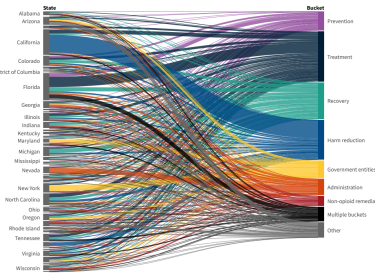
This Week's News in Substance Use: 2/15/19
Emergency Rooms Often Don't Do Enough for People Who Survive an Overdose, Tonic
A recent study of Medicaid claims in West Virginia, which has an opioid overdose rate more than three times the national average and the highest death rate from drug overdoses in the country, documented this disconnect.
Researchers analyzed claims for 301 people who had nonfatal overdoses in 2014 and 2015. By examining hospital codes for opioid poisoning, researchers followed the patients’ treatment, seeing if they were billed in the following months for mental health visits, opioid counseling visits, or prescriptions for psychiatric and substance [misuse] medications.
They found that fewer than 10 percent of people in the study received, per month, medications like naltrexone or buprenorphine to treat their substance use disorder. (Methadone is another option to treat substance use, but it isn’t covered by West Virginia’s Medicaid program and wasn’t included in the study.) In the month of the overdose, about 15 percent received mental health counseling. However, on average, in the year after the overdose, that number fell to fewer than 10 percent per month.
In Rap Video, Insys Opioid Salesmen Boasted of Their Prowess, The Boston Globe
Two young Insys Therapeutics salesmen wearing sunglasses and hoodies danced next to a giant spray bottle depicting the drug firm’s opioid product, in a thumping rap video made to prod sales representatives to get more doctors to prescribe the addictive painkiller.
“Insys Therapeutics, that is our name,” the associates sang. “We’re raising the bar and we’re changing the game. To be great it takes a decision, to be better than the competition.”
The five-minute video debuted in 2015 at an Insys national sales staff meeting, according to federal prosecutors. They played it Wednesday to a rapt US District Court jury in Boston in the racketeering conspiracy trial of John N. Kapoor, founder of Arizona-based Insys, and four former high-ranking company executives.
Health Plans Don’t Want Patients On Opioids. So What Are They Doing for Pain? Politico
The national effort to curb the opioid crisis faces another big potential obstacle — insurers who won’t pay for less-addictive ways to control patients’ pain.
Patients seeking other pain treatment options often find that their insurers won’t foot the bill or are forcing them to jump through maddening hoops to get coverage. Experts in and out of government worry that this will make it more difficult to reverse the deadly opioid crisis that killed more than 47,000 people nationwide in 2017, even as doctors cut back on opioid prescribing and state and federal governments step up efforts to prevent and treat addiction.
Many Rural Americans Have No Access to Buprenorphine, Filter
Nearly a third of rural Americans live in a county without access to buprenorphine—the gold standard for treating opioid use disorder, according to a new Pew fact sheet.
In contrast, almost all (97.8 percent) of urban-dwelling Americans live in cities that do have buprenorphine providers.
In order to be able to legally prescribe and dispense buprenorphine—one form of Medication Assisted Treatment (MAT)—clinicians must complete eight hours of mandatory training, apply for a waiver online, and maintain detailed records of prescribing and treatment activity.



